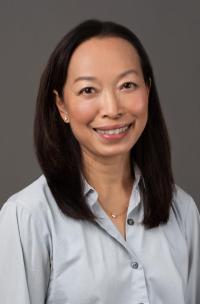Pamela Nguyen, DO, Appointed Program Director of the Neuroradiology Fellowship
The Department of Radiology is pleased to announce the appointment of Dr. Pamela Nguyen, assistant professor of radiology at Columbia University Irving Medical Center, as program director for the Neuroradiology Fellowship.
Dr. Nguyen was previously the associate program director for the fellowship, which trains four fellows each year. “I’m excited to build on our excellent foundation and lay the ground work for continued improvement in the training program,” said Dr. Nguyen.
Dr. Nguyen joined the Department of Radiology in 2016 and is a member of the Division of Neuroradiology, where she specializes in pediatric neuroradiology and head and neck imaging.
Q & A with Dr. Nguyen
What has been your involvement in education until now?
In addition to being the associate director of the neuro fellowship for the last five years, I’ve been very involved in medical student education. I worked with Dr. Pallavi Utukuri to update and optimize the neuroradiology block of the med student rotation on radiology, and I also give lectures for neuroradiology med student education.
What plans do you have for the fellowship under your leadership?
I plan to continue to provide the same excellent neuroradiology training, which is our main focus. We’re a one-year fellowship, and we train clinically excellent neuroradiologists.
In addition, I’d like to optimize the curriculum to reflect the latest advancements in neuroradiology. By that I mean journal clubs, grand rounds, and guest lecturers to expose our fellows to the most recent advancements in neuroradiology. We want to keep learning and exposing our fellows to developments in artificial intelligence and computer learning with regards to brain tumor assessment, for example, as well as advanced vascular imaging techniques.
What’s exceptional about the Columbia Neuroradiology Fellowship?
The caseload, variety, atmosphere, and level of teaching—I think that’s what makes us a really great program.
Columbia provides the most amazing pathology and variety of cases, starting with an excellent exposure to brain tumors because we have such busy neurosurgery and neurology departments. We also have a children’s hospital. So we have a great variety of cases and interesting pathology that you can only see at a quaternary care center university hospital like Columbia.
I also like the environment of being clinically busy, seeing a lot of different cases, and interacting with clinicians from other departments. It’s an atmosphere of collaboration which involves a lot of interaction with many clinically busy departments around the hospital. Our fellows interact with our neuroradiology attendings of course, but also with the neurology and neurosurgery attendings and residents, the ENT surgeons, pediatric neurologists, and members of the immunology division. That provides a rich experience for our fellows.
Why are you drawn to education?
I get excited about our many interesting and complex cases and it’s fun to share the enthusiasm I have for making diagnoses with someone else, and teaching is the perfect way to share that knowledge and excitement.
What's your approach to leadership?
I like to foster an environment of collaboration. I want our trainees to understand that they play such an important role in patient care so that they can feel pride in their work and really take ownership of their service. I like to be the person who has provided them with the tools for getting through a year where they have so many responsibilities. I think that allows them to flourish. I like to be very available.
I also like to lead by example. And finally, I think patience is important as a leader, and knowing that everyone is coming from a different setting and has a different comfort zone.
How do you think the COVID-19 pandemic has changed radiology fellowship education?
It’s been positive and negative of course. We’ve tried to identify the positives and take advantage of those. On any day some of the attendings are home and therefore they are more available. Instead of being stuck in traffic, they’re on their computers and you can get a hold of them. I also think it’s made everyone step up their game with technology. And it’s helped with accessibility to conferences. Now you can attend to your worklist and still listen in on a conference, or a lecture from an attending at another institution.

